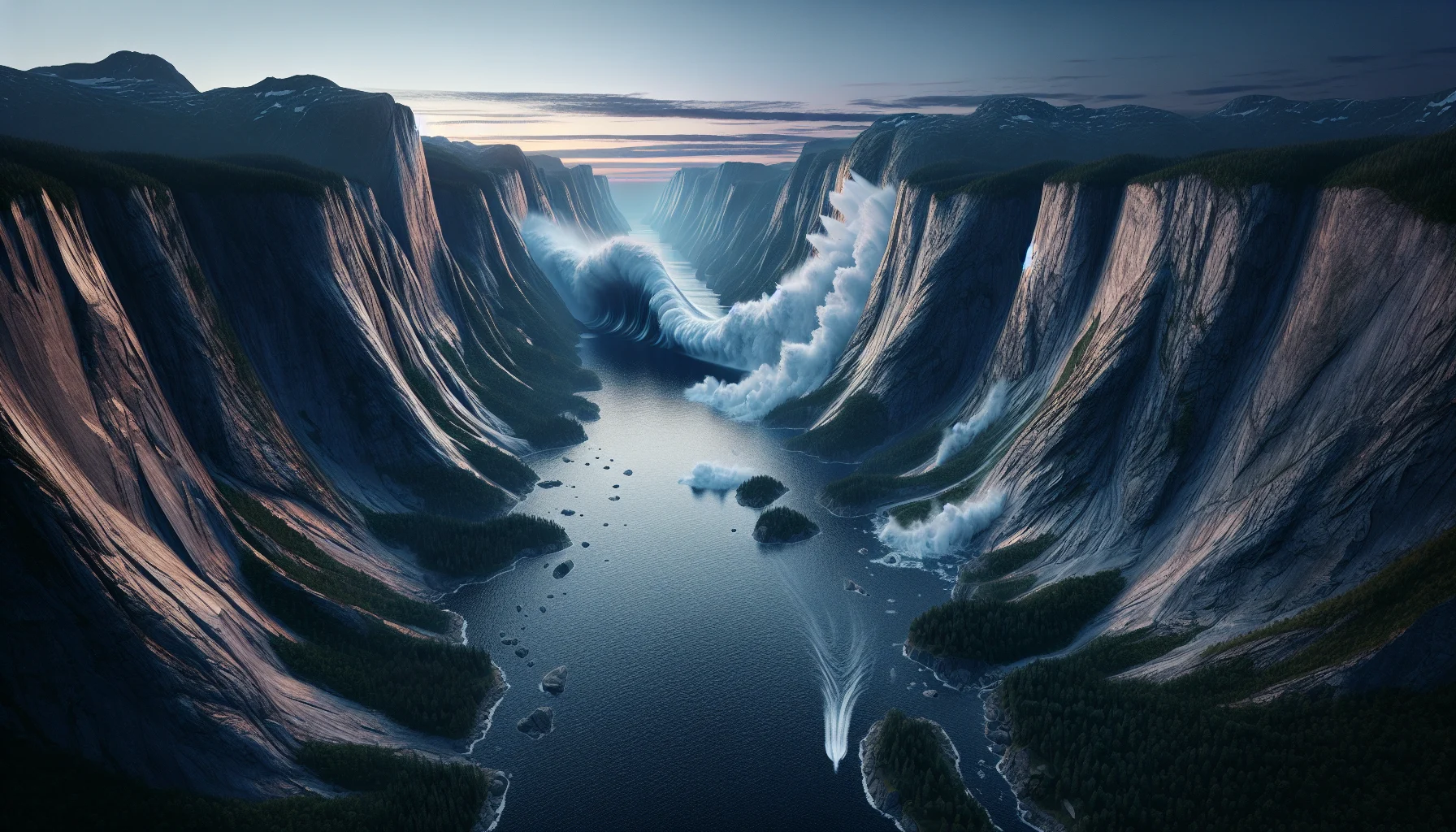
Lituya Bay Megatsunami
by: The Calamity Calendar Team
July 9, 1958
In the chill of an Alaskan night, wrapped beneath a veil of stars, the serene waters of Lituya Bay lay quietly at rest. Unspoken whispers of its geological past hinted at the bay's volatile potential. This was, after all, a place sculpted by the dramatic forces lying beneath the Earth's crust. Yet, even those familiar with the bay's history could not have anticipated the cataclysm that would strike on July 9, 1958, forever etching Lituya Bay in the annals of natural disasters.
Beneath the Surface: Seismic Volatility
The true story of this megatsunami begins millions of years in the making. Lituya Bay, a fjord nestled on the edge of the Gulf of Alaska, is part of the notorious Pacific Ring of Fire. This geologically restless belt is notorious for its seismic and volcanic activities. Here, the Earth's tectonic plates press against each other like unyielding wrestlers locked in an eternal embrace, sometimes jolting into action with spectacular force.
One such fault line, the Fairweather Fault, lies perilously beneath Lituya Bay. It was this precarious setting that set the stage for one of the largest earthquakes in the region's recorded history. In the early evening of July 9, the ground shuddered with a force measuring 7.8 on the Richter scale. This seismic event unfolded deep beneath the surface, unleashing energies ready to reshape the landscape.
The Tremor That Triggered a Titan
At approximately 10:15 PM, when many were retiring for the evening, the Fairweather Fault awakened. The earthquake sent shockwaves through the earth, causing a piece of the mountain towering above the Gilbert Inlet to break away. A staggering 30 million cubic meters of rock plunged thousands of feet into the calm waters below. This gigantic landslide acted much like a child’s hand slapping water in a bath, but on a scale beyond imagination.
The displaced water had only one direction to go: outwards. It formed a titanic wave, often called a megatsunami, something profoundly more monstrous than the regular oceanic tsunamis most are accustomed to hearing about. This wave didn’t merely cross the bay; it overran it. Reaching an apex at a nearly unfathomable 1,720 feet (524 meters), it holds the record as the tallest wave ever documented in human history.
The Tidal Fury Across Lituya Bay
As the wave washed over the mouth of the T-shaped fjord, its ferocity uprooted ancient trees as if they were mere twigs and carved into the landscape with relentless force. Three fishing boats were anchored in the bay that night. Amongst them, two were overwhelmed, pulled into the vortex of the fury, claiming the lives of two fishermen who met the water's indiscriminate wrath.
Thanks for subscribing!
Yet, amid the chaos, tales of survival emerged. One fishing boat, with its captain and crew gripped by fear and instinct, managed to ride the immense wave, ultimately surviving the ordeal. This small vessel's endurance amidst such devastation serves as a stark reminder of the unpredictable nature of the sea and those who face it.
Altered Landscape, Altered Understanding
The immediate aftermath was surreal. The dense forested landscape of Lituya Bay had been stripped bare, with swaths of land denuded of vegetation up to 1,720 feet high. The geological reshaping was significant, yet this was an event that affected few economically or in terms of human development, due to the remoteness of the region.
However, scientists were given a monumental task. The event became a subject of intense scrutiny, driving studies into the phenomenon of megatsunamis—especially those triggered by landslides. The Lituya Bay event offered an extraordinary observable case study, a rare opportunity to expand understanding of seismic interactions with marine environments. Such understanding aimed to illuminate the pathway to safeguarding other areas globally under similar threats.
The Long Shadow of the Tsunami
In the decades following the megatsunami, advances in technology have dramatically changed how such natural disasters are predicted and understood. Researchers continue to study Lituya Bay, using sophisticated tools to map landslide deposits and simulate the impacts of large-scale volcanic and seismic activities.
While Lituya Bay remains a largely untouched paradise, its history serves as a cautionary tale. The memory of 1958 resonates in scientific papers, textbooks, and as a dataset fueling the algorithms tasked with predicting future geological threats.
Where so much of the world still sees the bay as a tranquil, isolated inlet nestled in the rugged Alaskan wilderness, others see it as a sleeping giant. A fragile peace exists, one that can, as history proves, be disrupted.
A Lasting Impact
Today, the story of the Lituya Bay Megatsunami goes beyond just the data. It is a reminder of the raw and unpredictable power of nature. It speaks to the resilience of those who live and work at the mercy of the Earth's forces and serves as a testament to the bravery of the sailors who face perilous waters.
Moreover, the event has reshaped scientific approaches to understanding natural disasters, laying the groundwork for technologies that aim to safeguard human lives against nature's ultimate tests. This Alaskan fjord teaches us still, about not only the vulnerabilities of our natural world but the untapped strength within it.
Stay in the Loop!
Become a Calamity Insider and get exclusive Calamity Calendar updates delivered straight to your inbox.
Thanks! You're now subscribed.